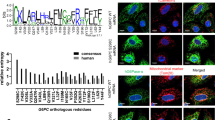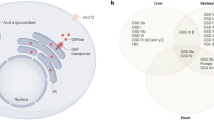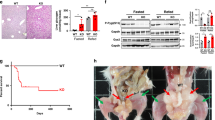Abstract
Glycogen storage disease type Ib (GSD-Ib) is caused by a deficiency in the glucose-6-phosphate transporter (G6PT), an endoplasmic reticulum-associated transmembrane protein that is ubiquitously expressed. GSD-Ib patients suffer from disturbed glucose homeostasis and myeloid dysfunctions. To evaluate the feasibility of gene replacement therapy for GSD-Ib, we have infused adenoviral (Ad) vector containing human G6PT (Ad-hG6PT) into G6PT-deficient (G6PT−/−) mice that manifest symptoms characteristics of the human disorder. Ad-hG6PT infusion restores significant levels of G6PT mRNA expression in the liver, bone marrow and spleen, and corrects metabolic as well as myeloid abnormalities in G6PT−/− mice. The G6PT−/− mice receiving gene therapy exhibit improved growth; normalized serum profiles for glucose, cholesterol, triglyceride, uric acid and lactic acid; and reduced hepatic glycogen deposition. The therapy also corrects neutropenia and lowers the elevated serum levels of granulocyte colony-stimulating factor. The development of bone and spleen in the infused G6PT−/− mice is improved and accompanied by increased cellularity and normalized myeloid progenitor cell frequencies in both tissues. This effective use of gene therapy to correct metabolic imbalances and myeloid dysfunctions in GSD-Ib mice holds promise for the future of gene therapy in humans.
This is a preview of subscription content, access via your institution
Access options
Subscribe to this journal
Receive 12 print issues and online access
$259.00 per year
only $21.58 per issue
Buy this article
- Purchase on Springer Link
- Instant access to full article PDF
Prices may be subject to local taxes which are calculated during checkout







Similar content being viewed by others
References
Chou JY, Matern D, Mansfield BC, Chen YT . Type I glycogen storage diseases: disorders of the glucose-6-phosphatase complex. Curr Mol Med 2002; 2: 121–143.
Chen Y-T . Glycogen storage diseases.In: Scriver CR, Beaudet AL, Sly WS, Valle D, Childs B, Kinzler KW, Vogelstein B (eds). The Metabolic and Molecular Bases of Inherited Disease, 8th edn. McGraw-Hill Inc.: New York, 2001, pp 1521–1551.
Lin B, Annabi B, Hiraiwa H, Pan C-J, Chou JY . Cloning and characterization of cDNAs encoding a candidate glycogen storage disease type 1b protein in rodents. J Biol Chem 1998; 273: 31656–31670.
Gitzelmann R, Bosshard NU . Defective neutrophil and monocyte functions in glycogen storage disease type 1b: a literature review. Eur J Pediatr 1993; 152: S33–S38.
Garty B, Douglas S, Danon YL . Immune deficiency in glycogen storage disease type 1b. Isr J Med Sci 1996; 32: 1276–1281.
Chou JY, Mansfield BC . Glucose-6-phosphate transporter: the key to glycogen storage disease type Ib.In: Broer S, Wagner CA (eds). Membrane Transporter Diseases. Kluwer Academic/Plenum Publishers: New York, 2003, pp 191–205.
Greene HL, Slonim AE, O’Neill Jr JA, Burr IM . Continuous nocturnal intragastric feeding for management of type 1 glycogen-storage disease. N Engl J Med 1976; 294: 423–425.
Chen YT, Cornblath M, Sidbury JB . Cornstarch therapy in type I glycogen storage disease. N Engl J Med 1984; 310: 171–175.
Schroten H, Roesler J, Breidenbach T, Wendel U, Elsner J, Schweitzer S et al. Granulocyte and granulocyte–macrophage colony-stimulating factors for treatment of neutropenia in glycogen storage disease type Ib. J Pediatr 1991; 119: 748–754.
Roe TF, Coates TD, Thomas DW, Miller JH, Gilsanz V . Brief report: treatment of chronic inflammatory bowel disease in glycogen storage disease type Ib with colony-stimulating factors. N Engl J Med 1992; 326: 1666–1669.
Pan C-J, Lin B, Chou JY . Transmembrane topology of human glucose-6-phosphate transporter. J Biol Chem 1999; 274: 13865–13869.
Chen L-Y, Shieh J-J, Lin B, Pan C-J, Gao J-L, Murphy PM et al. Impaired glucose homeostasis, neutrophil rafficking and function in mice lacking the glucose-6-phosphate transporter. Hum Mol Genet 2003; 12: 2547–2558.
Pan C-J, Kei K-J, Chen H, Ward JM, Chou JY . Ontogeny of the murine glucose-6-phosphatase system. Arch Biochem Biophys 1998; 358: 17–24.
Sieff CA, Nathan DG, Clark SC . The anatomy and physiology of hematopoiesis. In: Nathon DG, Orkin SH (eds). Hematology of Infancy and Childhood, 5th edn, vol.1. WB Saunders: Philadelphia, 1998, pp 161–236.
Wolber FM, Leonard E, Michael S, Orschell-Traycoff CM, Yoder MC, Srour EF . Roles of spleen and liver in development of the murine hematopoietic system. Exp Hematol 2002; 30: 1010–1019.
Lei K-J, Chen H, Pan C-J, Ward JM, Mosinger B, Lee EJ et al. Glucose-6-phosphatase dependent substrate transport in the glycogen storage disease type 1a mouse. Nat Genet 1996; 13: 203–209.
Hiraiwa H, Pan C-J, Lin B, Moses SW, Chou JY . Inactivation of the glucose-6-phosphate transporter causes glycogen storage disease type 1b. J Biol Chem 1999; 274: 5532–5536.
Lachaux A, Boillot O, Stamm D, Canterino I, Dumontet C, Regnier F et al. Treatment with lenograstim (glycosylated recombinant human granulocyte colony-stimulating factor) and orthotopic liver transplantation for glycogen storage disease type Ib. J Pediatr 1993; 123: 1005–1008.
Matern D, Starzl TE, Arnaout W, Barnard J, Bynon JS, Dhawan A et al. Liver transplantation for glycogen storage disease types I, III, and IV. Eur J Pediatr 1999; 158: S43–S48.
Martinez-Olmos MA, Lopez-Sanroman A, Martin-Vaquero P, Molina-Perez E, Barcena R, Vicente E et al. Liver transplantation for type Ib glycogenosis with reversal of cyclic neutropenia. Clin Nutr 2001; 20: 375–377.
Bhattacharya K, Heaton N, Rela M, Walter JH, Lee PJ . The benefits of liver transplantation in glycogenosis type Ib. J Inherit Metab Dis 2004; 27: 539–540.
Adachi M, Shinkai M, Ohhama Y, Tachibana K, Kuratsuji T, Saji H et al. Improved neutrophil function in a glycogen storage disease type 1b patient after liver transplantation. Eur J Pediatr 2004; 163: 202–206.
Breyer B, Jiang W, Cheng H, Zhou L, Paul R, Feng T et al. Adenoviral vector-mediated gene transfer for human gene therapy. Curr Gene Ther 2001; 1: 149–162.
Carter PJ, Samulski RJ . Adeno-associated viral vectors as gene delivery vehicles. Int J Mol Med 2000; 6: 17–27.
Mitani K, Graham FL, Caskey CT . Transduction of human bone marrow by adenoviral vector. Hum Gene Ther 1994; 5: 941–948.
Mitani K, Wakamiya M, Hasty P, Graham FL, Bradley A, Caskey CT . Gene targeting in mouse embryonic stem cells with an adenoviral vector. Somat Cell Mol Genet 1995; 21: 221–231.
Zhong L, Li W, Li Y, Zhao W, Wu J, Li B et al. Evaluation of primitive murine hematopoietic stem and progenitor cell transduction in vitro and in vivo by recombinant adeno-associated virus vector serotypes 1 through 5. Hum Gene Ther 2006; 17: 321–333.
Benihoud K, Yeh P, Perricaudet M . Adenovirus vectors for gene delivery. Curr Opin Biotechnol 1999; 10: 440–447.
Wilson JM . Adenovirus-mediated gene transfer to liver. Adv Drug Deliv Rev 2001; 46: 205–209.
Palmer DJ, Ng P . Helper-dependent adenoviral vectors for gene therapy. Hum Gene Ther 2005; 16: 1–16.
Alba R, Bosch A, Chillon M . Gutless adenovirus: last-generation adenovirus for gene therapy. Gene Therapy 2005; 12 (Suppl 1): S18–S27.
Tenenbaum L, Lehtonen E, Monahan PE . Evaluation of risks related to the use of adeno-associated virus-based vectors. Curr Gene Ther 2003; 3: 545–565.
Flotte TR . Gene therapy progress and prospects: recombinant adeno-associated virus (rAAV) vectors. Gene Therapy 2004; 11: 805–810.
Chen L-Y, Pan C-J, Shieh J-J, Chou JY . Structure-function analysis of the glucose-6-phosphate transporter deficient in glycogen storage disease type Ib. Hum Mol Genet 2002; 11: 3199–3207.
Acknowledgements
We thank Dr Brian C Mansfield for critical reading of the paper.
Author information
Authors and Affiliations
Corresponding author
Rights and permissions
About this article
Cite this article
Yiu, W., Pan, CJ., Allamarvdasht, M. et al. Glucose-6-phosphate transporter gene therapy corrects metabolic and myeloid abnormalities in glycogen storage disease type Ib mice. Gene Ther 14, 219–226 (2007). https://doi.org/10.1038/sj.gt.3302869
Received:
Revised:
Accepted:
Published:
Issue Date:
DOI: https://doi.org/10.1038/sj.gt.3302869
Keywords
This article is cited by
-
SLC transporters as therapeutic targets: emerging opportunities
Nature Reviews Drug Discovery (2015)
-
Liver transplantation in glycogen storage disease type I
Orphanet Journal of Rare Diseases (2014)
-
Inborn errors of metabolism underlying primary immunodeficiencies
Journal of Clinical Immunology (2014)
-
Congenital neutropenia: diagnosis, molecular bases and patient management
Orphanet Journal of Rare Diseases (2011)
-
Glycogen storage disease type I and G6Pase-β deficiency: etiology and therapy
Nature Reviews Endocrinology (2010)



